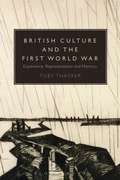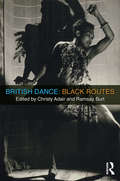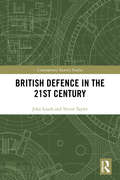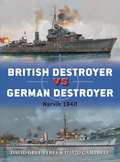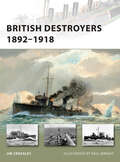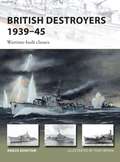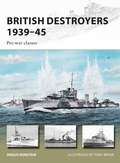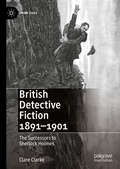- Table View
- List View
British culture and the end of empire (Studies in Imperialism #42)
by Andrew Thompson John M. MacKenzieThis book is the first major attempt to examine the cultural manifestations of the demise of imperialism as a social and political ideology in post-war Britain. Far from being a matter of indifference or resigned acceptance as is often suggested, the fall of the British Empire came as a profound shock to the British national imagination, and resonated widely in British popular culture. The sheer range of subjects discussed, from the satire boom of the 1960s to the worlds of sport and the arts, demonstrates how profoundly decolonisation was absorbed into the popular consciousness. Offers an extremely novel and provocative interpretation of post-war British cultural history, and opens up a whole new field of enquiry in the history of decolonisation.
British culture and the end of empire (Studies In Imperialism Ser.)
by Stuart WardThis book is the first major attempt to examine the cultural manifestations of the demise of imperialism as a social and political ideology in post-war Britain. Far from being a matter of indifference or resigned acceptance as is often suggested, the fall of the British Empire came as a profound shock to the British national imagination, and resonated widely in British popular culture. The sheer range of subjects discussed, from the satire boom of the 1960s to the worlds of sport and the arts, demonstrates how profoundly decolonisation was absorbed into the popular consciousness. Offers an extremely novel and provocative interpretation of post-war British cultural history, and opens up a whole new field of enquiry in the history of decolonisation.
British Culture and the First World War (Social History in Perspective)
by George RobbThe First World War has left its imprint on British society and the popular imagination to an extent almost unparalleled in modern history. Its legacy of mass death, mechanized slaughter, propaganda, and disillusionment swept away long-standing romanticized images of warfare, and continues to haunt the modern consciousness.Focusing on the lives of ordinary Britons, George Robb's engaging new study seeks to comprehend what it meant for an entire society to undergo the tremendous shocks and demands of total war; how it attempted to make sense of the conflict, explain it to others, and deal with the war's legacies.British Culture and the First World War- examines the war's impact on ideologies of race, class and gender, the government's efforts to manage news and to promote patriotism, the role of the arts and sciences, and the commemoration of the war in the decades since- synthesizes much of the best and most recent scholarship on the social and cultural history of the war- reclaims a great deal of neglected or forgotten popular cultural sources such as films, cartoons, juvenile literature and pulp fictionCompact but comprehensive, this accessible and refreshing text is essential reading for anyone interested in British society and culture during the turbulent years of the First World War.
British Culture and the First World War: Experience, Representation and Memory
by Toby ThackerThe First World War has been mythologized since 1918, and many paradigmatic views of it - that it was pointless, that brave soldiers were needlessly sacrificed - are deeply embedded in the British consciousness. More than in any other country, these collective British memories were influenced by the experiences and the work of writers, painters and musicians.This book revisits the British experience of the War through the eyes and ears of a diverse group of carefully selected novelists, poets, composers and painters. It examines how they reacted to and portrayed their experiences in the trenches on the Western Front, in distant theatres of war and on the home front, in words, pictures and music that would have a profound influence on subsequent British perceptions of the war.Rupert Brooke, Vera Brittain, Richard Nevinson, Paul Nash, Edward Elgar and T. E. Lawrence are amongst the figures discussed in this original exploration of the First World War and British collective memory. The book includes illustrations and maps to aid further study and research.
British Culture and the First World War: Experience, Representation and Memory
by Toby ThackerThe First World War has been mythologized since 1918, and many paradigmatic views of it - that it was pointless, that brave soldiers were needlessly sacrificed - are deeply embedded in the British consciousness. More than in any other country, these collective British memories were influenced by the experiences and the work of writers, painters and musicians.This book revisits the British experience of the War through the eyes and ears of a diverse group of carefully selected novelists, poets, composers and painters. It examines how they reacted to and portrayed their experiences in the trenches on the Western Front, in distant theatres of war and on the home front, in words, pictures and music that would have a profound influence on subsequent British perceptions of the war. Rupert Brooke, Vera Brittain, Christopher Nevinson, Paul Nash, Edward Elgar and T. E. Lawrence are amongst the figures discussed in this original exploration of the First World War and British collective memory. The book includes illustrations, maps and a companion website to aid further study and research.
British Cyprus and the Long Great War, 1914-1925: Empire, Loyalties and Democratic Deficit (Routledge Studies in First World War History)
by Andrekos VarnavaMost of the Cypriot population, especially the lower classes, remained loyal to the British cause during the Great War and the island contributed significantly to the First World War, with men and materials. The British acknowledged this yet failed to institute political and economic reforms once the war ended. The obsession of Greek Cypriot elites with enosis (union with Greece), which only increased after the war, and the British dismissal of increasing the role of Cypriots in government, bringing the Christian and Muslim communities closer, and expanding franchise to all classes and sexes, led to serious problems down the line, not least the development of a democratic deficit. Andrekos Varnava studies the events and the impact of this crucial period.
British Cyprus and the Long Great War, 1914-1925: Empire, Loyalties and Democratic Deficit (Routledge Studies in First World War History)
by Andrekos VarnavaMost of the Cypriot population, especially the lower classes, remained loyal to the British cause during the Great War and the island contributed significantly to the First World War, with men and materials. The British acknowledged this yet failed to institute political and economic reforms once the war ended. The obsession of Greek Cypriot elites with enosis (union with Greece), which only increased after the war, and the British dismissal of increasing the role of Cypriots in government, bringing the Christian and Muslim communities closer, and expanding franchise to all classes and sexes, led to serious problems down the line, not least the development of a democratic deficit. Andrekos Varnava studies the events and the impact of this crucial period.
British Dance: Black Routes
by Christy Adair Ramsay BurtBritish Dance, Black Routes is an outstanding collection of writings which re-reads the achievements of Black British dance artists, and places them within a broad historical, cultural and artistic context. Until now discussion of choreography by Black dance practitioners has been dominated by the work of African-American artists, facilitated by the civil rights movement. But the work produced by Black British artists has in part been within the context of Britain’s colonial legacy. Ramsay Burt and Christy Adair bring together an array of leading scholars and practitioners to review the singularity and distinctiveness of the work of British-based dancers who are Black and its relation to the specificity of Black British experiences. From sub-Saharan West African and Caribbean dance forms to jazz and hip-hop, British Dance, Black Routes looks afresh at over five decades of artistic production to provide an unparalleled resource for dance students and scholars.
British Dance: Black Routes
by Christy Adair Ramsay BurtBritish Dance, Black Routes is an outstanding collection of writings which re-reads the achievements of Black British dance artists, and places them within a broad historical, cultural and artistic context. Until now discussion of choreography by Black dance practitioners has been dominated by the work of African-American artists, facilitated by the civil rights movement. But the work produced by Black British artists has in part been within the context of Britain’s colonial legacy. Ramsay Burt and Christy Adair bring together an array of leading scholars and practitioners to review the singularity and distinctiveness of the work of British-based dancers who are Black and its relation to the specificity of Black British experiences. From sub-Saharan West African and Caribbean dance forms to jazz and hip-hop, British Dance, Black Routes looks afresh at over five decades of artistic production to provide an unparalleled resource for dance students and scholars. Appendix 2 of this book is freely available as a downloadable Open Access PDF at http://www.taylorfrancis.com under a Creative Commons Attribution-Non Commercial-No Derivatives (CC-BY-NC-ND) 4.0 license.
British Decolonization, 1946–1997: When, Why and How did the British Empire Fall? (British History in Perspective)
by David McintyreThe sudden demise of arguably the world's greatest empire in the years following the Second World War was a momentous event in global history. After nearly four centuries of colonial activity, the British relinquished their empire in a little more than twenty years. In this comprehensive new survey, David McIntyre narrates the sequence of decolonisation, summarises the historical controversies surrounding its causes, and considers what was distinctive about the way events unfolded. The author argues that although colonial self-government had a long pedigree going back to the American colonies (and Dominion status had become a peaceful evolutionary route to independence), the upsurge of colonial nationalisms after 1945 meant that policy-makers were overtaken by events. The great speed at which the numerous dependencies in Asia, Africa, the Caribbean and Pacific were relinquished is analysed and the Commonwealth since decolonisation reconsidered, revealing an association displaying surprising vigour in its post-Britannic years.
British Defence in the 21st Century (Contemporary Security Studies)
by John Louth Trevor TaylorThis book analyses UK defence as a complex, interdependent public-private enterprise covering politics, management, society, and technology, as well as the military. Building upon wide-ranging applied research, with extensive access to ministers, policy makers, senior military commanders, and industrialists, the book characterises British defence as a phenomenon that has endured extensive transformation this century. Looking at the subject afresh as a complex, extended enterprise involving politics, alliances, businesses, skills, economics, military practices, and citizens, the authors profoundly reshape our understanding of ‘defence’ and how it is to be commissioned and delivered in a world dominated by geopolitical risks and uncertainties. The book makes the case that this new understanding of defence must inevitably lead to new policies and processes to ensure its health and vitality. This book will be of much interest to students of defence studies, British politics, and military and strategic studies, as well as policy makers and practitioners.
British Defence in the 21st Century (Contemporary Security Studies)
by John Louth Trevor TaylorThis book analyses UK defence as a complex, interdependent public-private enterprise covering politics, management, society, and technology, as well as the military. Building upon wide-ranging applied research, with extensive access to ministers, policy makers, senior military commanders, and industrialists, the book characterises British defence as a phenomenon that has endured extensive transformation this century. Looking at the subject afresh as a complex, extended enterprise involving politics, alliances, businesses, skills, economics, military practices, and citizens, the authors profoundly reshape our understanding of ‘defence’ and how it is to be commissioned and delivered in a world dominated by geopolitical risks and uncertainties. The book makes the case that this new understanding of defence must inevitably lead to new policies and processes to ensure its health and vitality. This book will be of much interest to students of defence studies, British politics, and military and strategic studies, as well as policy makers and practitioners.
The British Dentist (Shire Library)
by Rachel BairstoThough the prospect may fill us with dread, most of us need dental treatment at some stage – and the reality is that better care has never been available, as this fully illustrated book shows. Early dentistry was amateurish and limited to barber-surgeons, travelling tooth-pullers and blacksmiths, with patients often suffering as much from the cure as the malady; and even as things improved in the eighteenth century, fashionable dentures were still made from the teeth of dead soldiers or even of the poor. This authoritative introduction looks at this whole grisly history as well as at the increasing professionalism seen from the late nineteenth century onwards, which has led to very dramatic improvements in dental treatment, including modern dentures, amalgam fillings, anaesthetics and orthodontics, and to the current boom in cosmetic dentistry.
British Design: Tradition and Modernity after 1948
by Christopher Breward Fiona Fisher Ghislaine WoodBritish Design brings together leading international scholars, designers and journalists to provide new perspectives on British design in the last sixty years, and how it at once looked back to the past with the continuation of traditions that spoke to Britain's design heritage, and looked forwards with the embrace of modernist and postmodernist style. The book responds to and develops new ways of understanding the recent history of design in Britain, with case studies on designed spaces and objects, including domestic interiors, retail spaces, schools and university buildings and transport. The contributors address significant moments and phenomena in the historical and social history of British design, from the rise and fall of the English Country House style and the Brutalist architectural boom of the 1960s to the modern shopping space, and consider the work of key contemporary designers ranging from Tommy Roberts to Thomas Heatherwick. British Design provides new criticism and analysis on how design, from the immediate post-war period to the present day, has developed and changed how we live and how we interact with the spaces in which we live.British Design is split into 13 chapters and is richly illustrated with 65 images, 16 of which are in full colour.
British Design: Tradition and Modernity after 1948 (Routledge Research In Architecture Ser.)
by Christopher Breward Fiona Fisher Ghislaine WoodBritish Design brings together leading international scholars, designers and journalists to provide new perspectives on British design in the last sixty years, and how it at once looked back to the past with the continuation of traditions that spoke to Britain's design heritage, and looked forwards with the embrace of modernist and postmodernist style. The book responds to and develops new ways of understanding the recent history of design in Britain, with case studies on designed spaces and objects, including domestic interiors, retail spaces, schools and university buildings and transport. The contributors address significant moments and phenomena in the historical and social history of British design, from the rise and fall of the English Country House style and the Brutalist architectural boom of the 1960s to the modern shopping space, and consider the work of key contemporary designers ranging from Tommy Roberts to Thomas Heatherwick. British Design provides new criticism and analysis on how design, from the immediate post-war period to the present day, has developed and changed how we live and how we interact with the spaces in which we live.British Design is split into 13 chapters and is richly illustrated with 65 images, 16 of which are in full colour.
British Destroyer vs German Destroyer: Narvik 1940 (Duel)
by David Greentree Alan Gilliland Mr Paul Wright Mr David CampbellThe opening months of World War II saw Britain's Royal Navy facing a resurgent German navy, the Kriegsmarine. Following the German invasion of Denmark and Norway in early April 1940, British and German destroyers would clash in a series of battles for control of the Norwegian coast. The operational environment was especially challenging, with destroyer crews having to contend with variable weather, narrow coastal tracts and possibility of fog and ship breakdowns.In two engagements at Narvik, the Royal Navy entered the harbour and attacked the loitering German destroyers who had dropped off mountain troops to support the German invasion. The raids were devastating, halving at a stroke the number at Hitler's disposal. Employing specially commissioned artwork and drawing upon a range of sources, this absorbing study traces the evolving technology and tactics employed by the British and German destroyer forces, and assesses the impact of the Narvik clashes on both sides' subsequent development and deployment of destroyers in a range of roles across the world's oceans.
British Destroyer vs German Destroyer: Narvik 1940 (Duel)
by Paul Wright David Greentree David Campbell Alan GillilandThe opening months of World War II saw Britain's Royal Navy facing a resurgent German navy, the Kriegsmarine. Following the German invasion of Denmark and Norway in early April 1940, British and German destroyers would clash in a series of battles for control of the Norwegian coast. The operational environment was especially challenging, with destroyer crews having to contend with variable weather, narrow coastal tracts and possibility of fog and ship breakdowns.In two engagements at Narvik, the Royal Navy entered the harbour and attacked the loitering German destroyers who had dropped off mountain troops to support the German invasion. The raids were devastating, halving at a stroke the number at Hitler's disposal. Employing specially commissioned artwork and drawing upon a range of sources, this absorbing study traces the evolving technology and tactics employed by the British and German destroyer forces, and assesses the impact of the Narvik clashes on both sides' subsequent development and deployment of destroyers in a range of roles across the world's oceans.
British Destroyers 1892–1918 (New Vanguard #163)
by Jim CrossleyThis book recounts the history of the first destroyers of the Royal Navy, which revolutionized the way war was fought at sea with new armaments and a great improvement on earlier designs. Moreover, between 1892, when the first destroyers were laid down, and 1918, destroyers evolved radically from 27-knot, 250-ton ships into 35-knot, 1,530-ton ships. All these ships were involved in some form during World War I; the smaller, original destroyers in an auxiliary support role and the newer, larger destroyers at some of the greatest sea battles of the war. This account highlights the role the destroyers played in the North Sea during the crucial battles to control the Heliogoland Bight, as well as the major fleet action at the battle of Jutland in 1916. Complete with a detailed description of the technical evolution of each class of destroyer from the 27-knotters to the Tribal and Marksman classes, Jim Crossley offers a complete overview of the vessels that helped to maintain Britain's naval supremacy.
British Destroyers 1892–1918 (New Vanguard)
by Paul Wright Jim CrossleyThis book recounts the history of the first destroyers of the Royal Navy, which revolutionized the way war was fought at sea with new armaments and a great improvement on earlier designs. Moreover, between 1892, when the first destroyers were laid down, and 1918, destroyers evolved radically from 27-knot, 250-ton ships into 35-knot, 1,530-ton ships. All these ships were involved in some form during World War I; the smaller, original destroyers in an auxiliary support role and the newer, larger destroyers at some of the greatest sea battles of the war. This account highlights the role the destroyers played in the North Sea during the crucial battles to control the Heliogoland Bight, as well as the major fleet action at the battle of Jutland in 1916. Complete with a detailed description of the technical evolution of each class of destroyer from the 27-knotters to the Tribal and Marksman classes, Jim Crossley offers a complete overview of the vessels that helped to maintain Britain's naval supremacy.
British Destroyers 1939–45: Wartime-built classes (New Vanguard)
by Tony Bryan Angus KonstamAs the possibility of war loomed in the 1930s, the British Admiralty looked to update their fleet of destroyers to compete with the new ships being built by Germany and Japan, resulting in the commissioning of the powerful Tribal-class. These were followed by the designing of the first of several slightly smaller ships, which carried fewer guns than the Tribals, but were armed with a greatly enlarged suite of torpedoes. The first of these, the 'J/K/M class' was followed by a number of wartime variants, with slight changes to their weaponry to suit different wartime roles.Designed to combat enemy surface warships, aircraft and U-boats, the British built these destroyers to face off against anything the enemy could throw at them. Using a collection of contemporary photographs and beautiful colour artwork, this is a fascinating new study of the ships that formed the backbone of the Royal Navy during World War II.
British Destroyers 1939–45: Wartime-built classes (New Vanguard #246)
by Tony Bryan Angus KonstamAs the possibility of war loomed in the 1930s, the British Admiralty looked to update their fleet of destroyers to compete with the new ships being built by Germany and Japan, resulting in the commissioning of the powerful Tribal-class. These were followed by the designing of the first of several slightly smaller ships, which carried fewer guns than the Tribals, but were armed with a greatly enlarged suite of torpedoes. The first of these, the 'J/K/M class' was followed by a number of wartime variants, with slight changes to their weaponry to suit different wartime roles.Designed to combat enemy surface warships, aircraft and U-boats, the British built these destroyers to face off against anything the enemy could throw at them. Using a collection of contemporary photographs and beautiful colour artwork, this is a fascinating new study of the ships that formed the backbone of the Royal Navy during World War II.
British Destroyers 1939–45: Pre-war classes (New Vanguard #246)
by Angus KonstamThe Royal Navy entered World War II with a large but eclectic fleet of destroyers. Some of these were veterans of World War I, fit only for escort duties. Most though, had been built during the inter-war period, and were regarded as both reliable and versatile. Danger though lurked across the seas as new destroyers being built in Germany, Italy and Japan were larger and better armoured. So, until the new, larger Tribal-class destroyers could enter service, these vessels would have to hold the line. Used mainly to hunt submarines, protect convoys from aerial attack, and take out other destroyers, these ships served across the globe during the war. This fully illustrated study is the first in a two-part series on the real workhorses of the wartime Royal Navy, focusing on how these ageing ships took on the formidable navies of the Axis powers.
British Destroyers 1939–45: Pre-war classes (New Vanguard #246)
by Angus KonstamThe Royal Navy entered World War II with a large but eclectic fleet of destroyers. Some of these were veterans of World War I, fit only for escort duties. Most though, had been built during the inter-war period, and were regarded as both reliable and versatile. Danger though lurked across the seas as new destroyers being built in Germany, Italy and Japan were larger and better armoured. So, until the new, larger Tribal-class destroyers could enter service, these vessels would have to hold the line. Used mainly to hunt submarines, protect convoys from aerial attack, and take out other destroyers, these ships served across the globe during the war. This fully illustrated study is the first in a two-part series on the real workhorses of the wartime Royal Navy, focusing on how these ageing ships took on the formidable navies of the Axis powers.
British Detective Fiction 1891–1901: The Successors to Sherlock Holmes (Crime Files)
by Clare ClarkeThis book examines the developments in British serial detective fiction which took place in the seven years when Sherlock Holmes was dead. In December 1893, at the height of Sherlock’s popularity with the Strand Magazine’s worldwide readership, Arthur Conan Doyle killed off his detective. At the time, he firmly believed that Holmes would not be resurrected. This book introduces and showcases a range of Sherlock’s most fascinating successors, exploring the ways in which a huge range of popular magazines and newspapers clamoured to ensnare Sherlock’s bereft fans. The book’s case-study format examines a range of detective series-- created by L.T. Meade; C.L. Pirkis; Arthur Morrison; Fergus Hume; Richard Marsh; Kate and Vernon Hesketh-Prichard— that filled the pages of a variety of periodicals, from plush monthly magazines to cheap newspapers, in the years while Sherlock was dead. Readers will be introduced to an array of detectives—professional and amateur, male and female, old and young; among them a pawn-shop worker, a scientist, a British aristocrat, a ghost-hunter. The study of these series shows that there was life after Sherlock and proves that there is much to learn about the development of the detective genre from the successors to Sherlock Holmes.“In this brilliant, incisive study of late Victorian detective fiction, Clarke emphatically shows us there is life beyond Sherlock Holmes. Rich in contextual detail and with her customary eye for the intricacies of publishing history, Clarke’s wonderfully accessible book brings to the fore a collection of hitherto neglected writers simultaneously made possible but pushed to the margins by Conan Doyle’s most famous creation.” — Andrew Pepper,, Senior Lecturer in English and American Literature, Queen's University, Belfast Professor Clarke's superb new book, British Detective : The Successors to Sherlock Holmes, is required reading for anyone interested in Victorian crime and detective fiction. Building on her award-winning first monograph, Late-Victorian Crime Fiction in the Shadows of Sherlock, Dr. Clarke further explores the history of serial detective fiction published after the "death" of Conan Doyle's famous detective in 1893. This is a path-breaking book that advances scholarship in the field of late-Victorian detective fiction while at the same time introducing non-specialist readers to a treasure trove of stories that indeed rival the Sherlock Holmes series in their ability to puzzle and entertain the most discerning reader. — Alexis Easley, Professor of English, University of St.Paul, Minnesota
British Diesel Locomotives of the 1950s and ‘60s (Shire Library)
by Greg MorseAfter the Second World War, the drive for the modernisation of Britain's railways ushered in a new breed of locomotive: the Diesel. Diesel-powered trains had been around for some time, but faced with a coal crisis and the Clean Air Act in the 1950s, it was seen as a part of the solution for British Rail. This beautifully illustrated book, written by an expert on rail history, charts the rise and decline of Britain's diesel-powered locomotives. It covers a period of great change and experimentation, where the iconic steam engines that had dominated for a century were replaced by a series of modern diesels including the ill-fated 'Westerns' and the more successful 'Deltics'.



